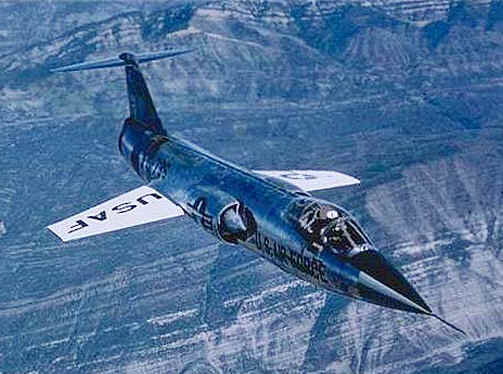|

Photo Copyright 1997 Tarek Saghir
History: In 1954, the Lockheed Company's famed designer, Kelly Johnson, created a new
single-seat fighter design for use in the Korean conflict by the US Air Force. He made it
small and relatively light, with a massive, powerful engine -- a combination which would
make it very fast and very capable as an interceptor. The first XF-104
prototype was first flown on 7 February 1954, but nearly four years of development took
place before the USAF began using the aircraft. During this time the Air Force became
disinterested in fighters of the F-104's class, and they purchased less than 300 of them.
However, several other allied countries, under the leadership of West Germany, decided to
manufacture an improved version for themselves. Production began in no fewer than six
locations, including Belgium, Canada, Italy, Japan, the Netherlands and West Germany. When
production ended, 2282 additional F-104s had been built by other nations.
Major production variants included the F-104A
(first production version); NF-104A (modified F-104A used for
astronaut training; utilized maneuvering thrusters on wings and fuselage for control at
high altitudes); F-104C (tactical and nuclear-strike version
built for the USAF's Tactical Air Command); F-104G (major
production variant built in several countries and utilizing a strengthened structure, more
advanced avionics, and various aerodynamic improvements); RF-104G
(tactical reconnaissance version); CF-104 (Canadian-built
version of the F-104G with removable aerial refueling probe). Aeritalia later developed a
multi-role version called the F-104S for the Italian and Turkish
air forces.
In 1985, the Italian Air Force began upgrading 150
Starfighters with modern radar, improved self-protection systems and avionics, and
up-to-date weapons-delivery capability. These aircraft, designated F-104S-ASAs,
are still in front-line service, and are expected to remain flying until the Eurofighter
replaces them in approximately 2001. At least three F-104s are now flown by private owners
in the USA, and several more are under restoration.
Nicknames: Zipper; "Missile With A
Man In It"; Witwenmacher "Widowmaker" (Bundesluftwaffe nickname); Flying
Coffin; Ground Nail; Bullet & Blades; Badmash "Wicked One" (Pakistani nickname for
F-104As), Eiko "Glory" (Japanese nickname for F-104Js), Spaghetti
Starfighter (Italian nickname for F-104S-ASAs.)
Specifications
(F-104G):
Engine: One 15,600-lb thrust General Electric J79-GE-11A
afterburning turbojet.
Weight: Empty 13,990 lbs., Max Takeoff 29,030 lbs.
Wing Span: 21ft. 9in.
Length: 54ft. 8in.
Height: 13ft. 5in.
Performance:
Maximum Speed at 50,000 ft: 1,145
mph (Mach 2.2)
Ceiling: 50,000 ft.
Range: 1,080 miles
Armament:
One 20-mm six-barreled cannon
Two wingtip-mounted Sidewinder
air-to-air missiles
Up to 4,000 lbs. of bombs,
missiles, rockets and other stores.
Number Built: Approximately 2,515
Number Still Airworthy: At least 3 in
private ownership; Unknown number in active service worldwide.
Links:
Cavanaugh Flight
Museum F-104 Page
Federation of American Scientists (FAS) F-104 Page
Harry's F-104
Starfighter Site
International
F-104 Society
Last of the
Dutch Starfighters
Michigan F-104 Page
-- An F-104 restoration in the USA.
NASA
Dryden F-104 Photo Collection
"North American
Eagle" -- Land speed record challenger, created from the fuselage
of an F-104A.
Norwegian
F-104 Starfighter Site -- An excellent and interesting site.
Ruminations on the F-104 -- A pilot's recollections of flying the -104.
Starfighters.net
Wikipedia F-104 Entry
Fly the incredible
F-104!
Click on the photo below for more information.


[Back to Warbird Alley's Main
Page]
All text and photos Copyright 2016 The
Doublestar Group, unless otherwise noted.
You may use this page for your own, non-commercial reference purposes only.
 |